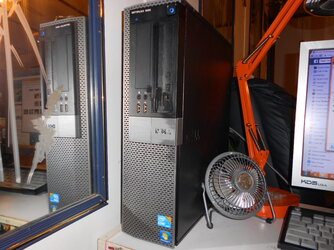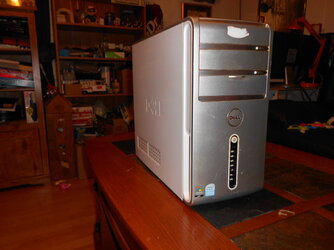-
Welcome to Overclockers Forums! Join us to reply in threads, receive reduced ads, and to customize your site experience!
You are using an out of date browser. It may not display this or other websites correctly.
You should upgrade or use an alternative browser.
You should upgrade or use an alternative browser.
Why is the Mother board so different in a Dell Opltiplex 980?
- Thread starter DellO980
- Start date
Not all the time, but generally, you're correct.Big Manufacture's like dell don't youse the standard ATX format it is all proprietary from there design.
Not all the time, but generally, you're correct.
LOL, Have you ever seen DELL,HP,Gateway use ATX standard. I use to work on them all the time.
Last edited:
Absolutely.LOL, Have you ever seen DELL,HP,Gatway use ATX standard. I use to work on them all the time.
- Joined
- Sep 13, 2015
LOL, Have you ever seen DELL,HP,Gatway use ATX standard. I use to work on them all the time.
I have a gateway that uses a standard atx layout.
Absolutely.
I have a gateway that uses a standard atx layout.
Have you ever tried to swap boards with a standard ATX board the screws, standoffs wont line up.
Let me explain it is proprietary meaning wen I was working in the OEM, PC field the manufacture's would purposely make things off so you have to buy there parts, except most of PCI and PCI-E slots work if you could fit the cards .
So I would have to order PSU, motherboards and the cases have proprietary wiring and standoffs, so if the case was damaged I would have to buy a new case from the manufacture.
That is the way it has ben from 2000 till now for me when I started working on OEM. You cant blame them for wanting to sell parts, after or during the 1-3 years. 7.3 billon people in the world that's allot of PC's and Parts.
The home user can drill and tap and cut and rewire to his heart is content.
Last edited:
I know what proprietary means.
And I'm telling you, I have at least a half dozen Dell boxes here with standard ATX format. I have aftermarket boards in all of them. I drilled nothing. The OEM's started sliding towards the standard right around socket 775 or so.
And I'm telling you, I have at least a half dozen Dell boxes here with standard ATX format. I have aftermarket boards in all of them. I drilled nothing. The OEM's started sliding towards the standard right around socket 775 or so.
- Joined
- Jun 28, 2012
I know what proprietary means.
And I'm telling you, I have at least a half dozen Dell boxes here with standard ATX format. I have aftermarket boards in all of them. I drilled nothing. The OEM's started sliding towards the standard right around socket 775 or so.
Replaced my buddy's HP mainboard with a an aftermarket board and did 100% of nothing to the case.
Dell recycles model numbers over generations. You'll need to specify. The 980 you have looks like maybe the Core 2 era version? The ones I last worked on were Sandy Bridge era - they were at least kinda standard.
BUT GUYS! Dell actually tends to use BTX these days. But... yea they also like to use weird connectors - and I'm not talking the way back ATX pin-swap fiasco, more that things like the CPU fan in say (SOME! revisions) small form factor OptiPlex GX520, minturized ATX PSU connectors (what the fsck?) and laptop PATA ribbons etc that will drive you mad...
The standard mid-tower optiplexes *tend* to be BTX (I think the MT models). The smaller "desktop" (DT?) is usually BTX but chopped to half height cards. Small form factor (SSF) in older models (before core2 - think P4 and earlier) was proprietary'ish "almost BTX/TFX but with our ribbon Dell flavor" hell - but newer i7's are kinda BTX cause things are more integrated. The smallest "Ultra Small Form Factor" (SFF) are always a nightmare (laptop parts and use a power brick - arrrgghhh).
Added to clarify: Dell tends to use BTX in OptiPlex series. Other series like Vostro/Inspiron tend to be ATX.
BUT GUYS! Dell actually tends to use BTX these days. But... yea they also like to use weird connectors - and I'm not talking the way back ATX pin-swap fiasco, more that things like the CPU fan in say (SOME! revisions) small form factor OptiPlex GX520, minturized ATX PSU connectors (what the fsck?) and laptop PATA ribbons etc that will drive you mad...
The standard mid-tower optiplexes *tend* to be BTX (I think the MT models). The smaller "desktop" (DT?) is usually BTX but chopped to half height cards. Small form factor (SSF) in older models (before core2 - think P4 and earlier) was proprietary'ish "almost BTX/TFX but with our ribbon Dell flavor" hell - but newer i7's are kinda BTX cause things are more integrated. The smallest "Ultra Small Form Factor" (SFF) are always a nightmare (laptop parts and use a power brick - arrrgghhh).
Added to clarify: Dell tends to use BTX in OptiPlex series. Other series like Vostro/Inspiron tend to be ATX.
Last edited:
- Joined
- Feb 18, 2007
Ehh... I've never encountered an "unusual" board that fully resembles a normal m/ATX. I've swapped around many micro and full size ATX boards from IBM, HP, Compaq, Dell, Gateway and others and if they appeared to be normal boards, with a normal IO shield and no riser I have never had an issue.
Have a custom box on the desk beside me, "gateway" (intel) atx board from 15 years ago sitting in a custom case running a P3 1GHz.
Not sure if you're a neat freak or not, and how important the cooling and expansion is, but you may not need another case.
I've done everything from hot glue or tape to drilling holes and making brackets to add more hard drives to a system. Done this multiple times both inside and outside a case. For video cards if you were to need a riser to fit a larger one, check out ebay for flexible PCIE risers. Dirt cheap.
Cooling solutions can also be improvised, but if you're running a stock system I wouldn't sweat it. Toss in a big video card... then you might need some serious cooling.
Have a custom box on the desk beside me, "gateway" (intel) atx board from 15 years ago sitting in a custom case running a P3 1GHz.
Alright thanks for the help. But now I have a Dell Inspiron 530 laying around.
Not sure if you're a neat freak or not, and how important the cooling and expansion is, but you may not need another case.
I've done everything from hot glue or tape to drilling holes and making brackets to add more hard drives to a system. Done this multiple times both inside and outside a case. For video cards if you were to need a riser to fit a larger one, check out ebay for flexible PCIE risers. Dirt cheap.
Cooling solutions can also be improvised, but if you're running a stock system I wouldn't sweat it. Toss in a big video card... then you might need some serious cooling.
Assuming that's a core 2 era machine, the google pictures for that looks like it microATX. Same frame used for Vostro 230 et. al.But now I have a Dell Inspiron 530 laying around.
If you want to re-use the OEM Dell motherboard somewhere else - to solve the annoying "USB reader not present, press F1 to continue" message every boot when you don't have the card reader present read on:
Find the USB header on the mobo listed as F_USB or USB_1 (usually it's a different color than others). Put a jumper across Shield ground and ground. Fixed.
USB pins 8 and 10. So in crude ascii diagram...
(note ... 0 = pin 10, x = no pin)
x7531
08642
.::::
jumper "0" (10) and "8"
I think the back panel is just a sticker? If there isn't an I/O plate to knock out then you'll want a pair of "metal nippers."
good luck!
Similar threads
- Replies
- 2
- Views
- 469

